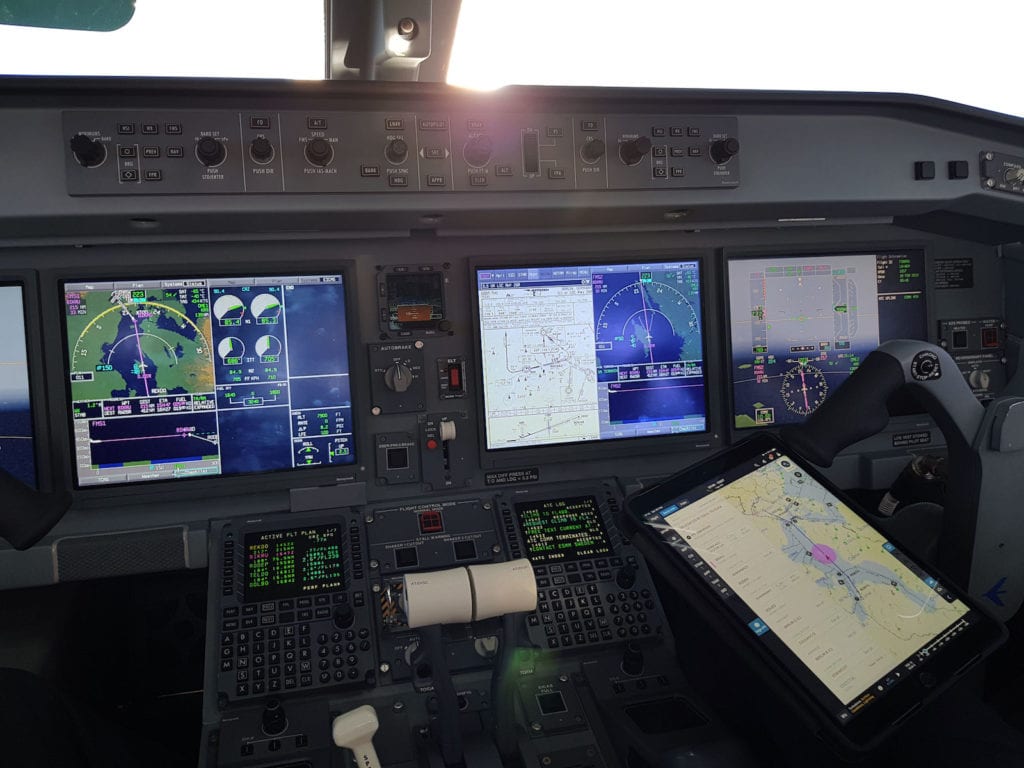
Jeppesen’s tailored charts for avionics in cockpit. Photo: Jeppesen
Norwegian regional airline Wideroe is adding tailored Jeppesen avionics charting to its fleet of Embraer E-190 E2 jets, giving its pilots the ability to use their front-panel avionics and electronic flight bag (EFB) tablets interchangeably.
Wideroe, which became the first airline to start operating Embraer’s second generation regional airliners in April 2018, is adding a software upgrade to its Honeywell Primus avionics to enable Jeppesen’s “Tailored Charts for Avionics” technology. The upgrades will allow Wideroe pilots to view airline-specific charting and navigation information, the same as displayed on their iPads, right on the front-panel avionics displays.
Embraer’s standard E2 cockpit configuration features four 13-inch landscape displays with synthetic vision and other advanced flight information graphics capabilities.
Jeppesen has been providing such tailored charts capability in the business and general aviation segment for the last decade on other platforms including the G1000 and Pro Line Fusion. A representative for Jeppesen confirmed Boeing’s plans to introduce the tailored charts upgrade to “other popular avionics manufacturer systems in the future to serve airlines, government operators and business aviation pilots.”
A team of representatives for Jeppesen provided responses to emailed questions about how the upgrade would be added to the E2s, and what noticeable difference pilots would see in real-time while flying with the new tailored avionics charting capabilities. According to the team, normally, the tailored charts capability is a navigation database update usually performed by a technician using a data card or wireless update distributed directly to the avionics operating system.
However, on the E2, wireless connectivity will enable the upgrade.
“In the Embraer E2 case configured with the wireless server unit, databases will automatically upload to the aircraft through internet connectivity, when the database becomes available, and will reside at a staged status for the final load to the avionics performed by the operator,” a representative for Jeppesen told Avionics International.
 | Want to hear more on aircraft connectivity applications? Check out the Global Connected Aircraft Podcast, where Avionics editor-in-chief Woodrow Bellamy III interviews airlines and industry influencers on how they’re applying connectivity solutions. |
At Wideroe, the flight operations division has been able to completely eliminate paper charting, now that they have standard and tailored charts available on two different navigational devices, according to Espen Bergsland chief pilot at Wideroe.
“Our pilots are able to view the active phase of flight on front panel avionics while we display the next phase of flight on tablet EFB, allowing our flight deck crew to execute tasks independently,” Bergsland said.
Wideroe is one of several airlines that is taking a customized approach to the way it integrates EFB applications with installed avionics systems and displays, a topic recently covered in the August 2019 edition of Avionics.
Boeing’s digital solutions and analytics division has not yet released a timeline on when the tailored avionics charts upgrade will be made available on other commercial aircraft models.